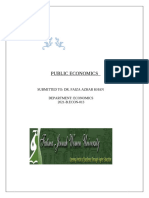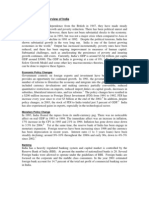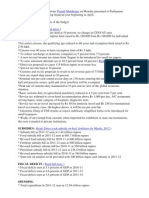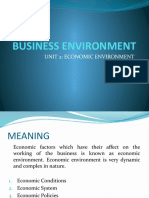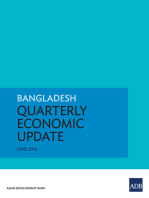Indian Economy-Overview
Uploaded by
markandeyulumIndian Economy-Overview
Uploaded by
markandeyulumIndian economy-Overview
India's diverse economy encompasses traditional village farming, modern agriculture, a wide range of modern industries and a multitude of services. India's GDP during 2012-13 is estimated at 5%. But it is expected to increase between 6.1 percent to 6.7 % in 2013-14. Inflation expected to fall between 6.2 % and 6.6 % during 2013-14. The country's exports were worth $25587 million by October in 2012-13 FDI inflows into India declined from $31.5 billion in 2011 to $27.3 billion in 2012 In 2012, FIIs bought equities worth USD 24.4 billion in 2012. The trade deficit for April - January, 2012-13 was estimated at US $ 167168.12 million, which was higher than the deficit of US $ 154890.14 million during April -January, 2011-12.
Fiscal Policy effect on Indian Economy
Fiscal policy is the means by which a government adjusts its levels of spending in order to monitor and influence a nations economy. Macroeconomic goals of Fiscal policy: I. Economic Growth II. Employment III. Stabilization IV. Economic Equality V. Price stability Instruments of Fiscal Policies: Taxation Public Expenditure Public Debt
Evaluation of Fiscal Policy
Early 1980s: Net of depreciation consistently negative. Late 1980s: Large deficit averaging about 8% of GDP Post liberalization: Fiscal deficit decreased. 2001: Fiscal deficit increased to 10% of GDP. 2003: FRBM was adopted. FRBM improved the transparency in budgetary policy. As a result fiscal deficit decreased to 3.7% of GDP. In 2007-2008 fiscal deficit was 2.7 % Shot up to 5.7 % in 20012-2013. Crowding out : the government borrows such large amounts of capital to finance government projects, its activities can increase interest rates. Higher interest rates discourage individuals and businesses from borrowing money, which reduces their spending and investment activities.
You might also like
- MEE-7-Fiscal - Monetary Policy-Final (2021) - ClassNo ratings yetMEE-7-Fiscal - Monetary Policy-Final (2021) - Class21 pages
- A Study on Fiscal Policy Impact on Indian Economy 2No ratings yetA Study on Fiscal Policy Impact on Indian Economy 226 pages
- Highlights and Summary - The Indian Economy - A Review0No ratings yetHighlights and Summary - The Indian Economy - A Review047 pages
- Presentation On Fiscal Policy of India: Submitted To:-Mrs. Anuradha MittalNo ratings yetPresentation On Fiscal Policy of India: Submitted To:-Mrs. Anuradha Mittal19 pages
- ECONOMETRIC STUDY OF THE IMPACT OF BUDGET DEFICIT ON NIGERIA ECONOMY (1970 - 2017)No ratings yetECONOMETRIC STUDY OF THE IMPACT OF BUDGET DEFICIT ON NIGERIA ECONOMY (1970 - 2017)54 pages
- SM Contemporary Issues Notes (December)No ratings yetSM Contemporary Issues Notes (December)21 pages
- Presentation On Fiscal and Monetary Policy in India100% (1)Presentation On Fiscal and Monetary Policy in India23 pages
- Economic and Social Issues (Esi) Fiscal Policy Summary Sheet For Rbi Grade B and Nabard Grade A/B 2019No ratings yetEconomic and Social Issues (Esi) Fiscal Policy Summary Sheet For Rbi Grade B and Nabard Grade A/B 201911 pages
- KPMG Flash News Economic Survey 2010 11No ratings yetKPMG Flash News Economic Survey 2010 1110 pages
- Commercial Policy and Economic Growth: BY Kavya .K Akash. A Apoorva. JNo ratings yetCommercial Policy and Economic Growth: BY Kavya .K Akash. A Apoorva. J16 pages
- Fiscal Reform Measures:: Ge.4: Indian Economy-Ii Unit-I Macroeconomic Policies and Their ImpactNo ratings yetFiscal Reform Measures:: Ge.4: Indian Economy-Ii Unit-I Macroeconomic Policies and Their Impact4 pages
- Fiscal and Monetary Policy of INDIA.pptxNo ratings yetFiscal and Monetary Policy of INDIA.pptx28 pages
- Economic Reforms in India Since 1991: Has Gradualism Worked? by Montek S. AhluwaliaNo ratings yetEconomic Reforms in India Since 1991: Has Gradualism Worked? by Montek S. Ahluwalia18 pages
- Fiscal Policies of Developing EconomiesNo ratings yetFiscal Policies of Developing Economies25 pages
- Analysis of Indian Economic Growth & DevelopmentNo ratings yetAnalysis of Indian Economic Growth & Development33 pages
- January February March April May: PeriodNo ratings yetJanuary February March April May: Period3 pages



















